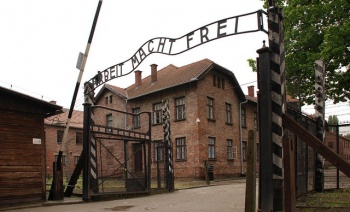
Over a million people, the vast majority of them Jews, were exterminated by the Nazis at Auschwitz during the Holocaust
World War Two is the deadliest conflict in history. The Nazi invasion of Poland sparked the war on 1 September 1939, and between late 1939 and early 1941 Nazi Germany gained control of much of continental Europe. Germany’s attack on the Soviet Union was less successful however, and Nazi forces became bogged down in a war of attrition. In December 1941, Japan attacked American military forces at Pearl Harbor in Hawaii, and quickly conquered vast swathes of the western Pacific. America entered the war in response, fighting not only Japanese forces, but joining British and French forces in the European theater. Slowly the tide of the war turned in 1942. Japan lost the crucial Battle of Midway, while Germany was defeated in North Africa and at Stalingrad in the Soviet Union. As the war continued, Nazi Germany vigorously pursued a policy of racial extermination. During the Holocaust, more than six million Jews and other minorities were systematically murdered. Ultimately, both Germany and Japan were defeated, but at tremendous cost for all parties. Meanwhile, the war had also led to the devastating new technology of the atomic bomb. By the end of the war, on 15 August 1945, there were an estimated 50 million to 85 million casualties. World War Two also led to major changes in global power structures and political alignments.
During this learning pathway you will watch one video lecture, two animations and complete several readings.
- Learn about the major events and turning points of World War Two, in Europe and Asia
- Reflect on the creation and use of the atomic bomb
World War Two is the deadliest conflict in history. The Nazi invasion of Poland sparked the war on 1 September 1939, and between late 1939 and early 1941 Nazi Germany gained control of much of continental Europe. Germany’s attack on the Soviet Union was less successful however, and Nazi forces became bogged down in a war of attrition. In December 1941, Japan attacked American military forces at Pearl Harbor in Hawaii, and quickly conquered vast swathes of the western Pacific. America entered the war in response, fighting not only Japanese forces, but joining British and French forces in the European theater. Slowly the tide of the war turned in 1942. Japan lost the crucial Battle of Midway, while Germany was defeated in North Africa and at Stalingrad in the Soviet Union. As the war continued, Nazi Germany vigorously pursued a policy of racial extermination. During the Holocaust, more than six million Jews and other minorities were systematically murdered. Ultimately, both Germany and Japan were defeated, but at tremendous cost for all parties. Meanwhile, the war had also led to the devastating new technology of the atomic bomb. By the end of the war, on 15 August 1945, there were an estimated 50 million to 85 million casualties. World War Two also led to major changes in global power structures and political alignments.
During this learning pathway you will watch one video lecture, two animations and complete several readings.
Objectives
Content is available under the
Creative Commons Attribution Share Alike License.
Privacy Policy | Authors